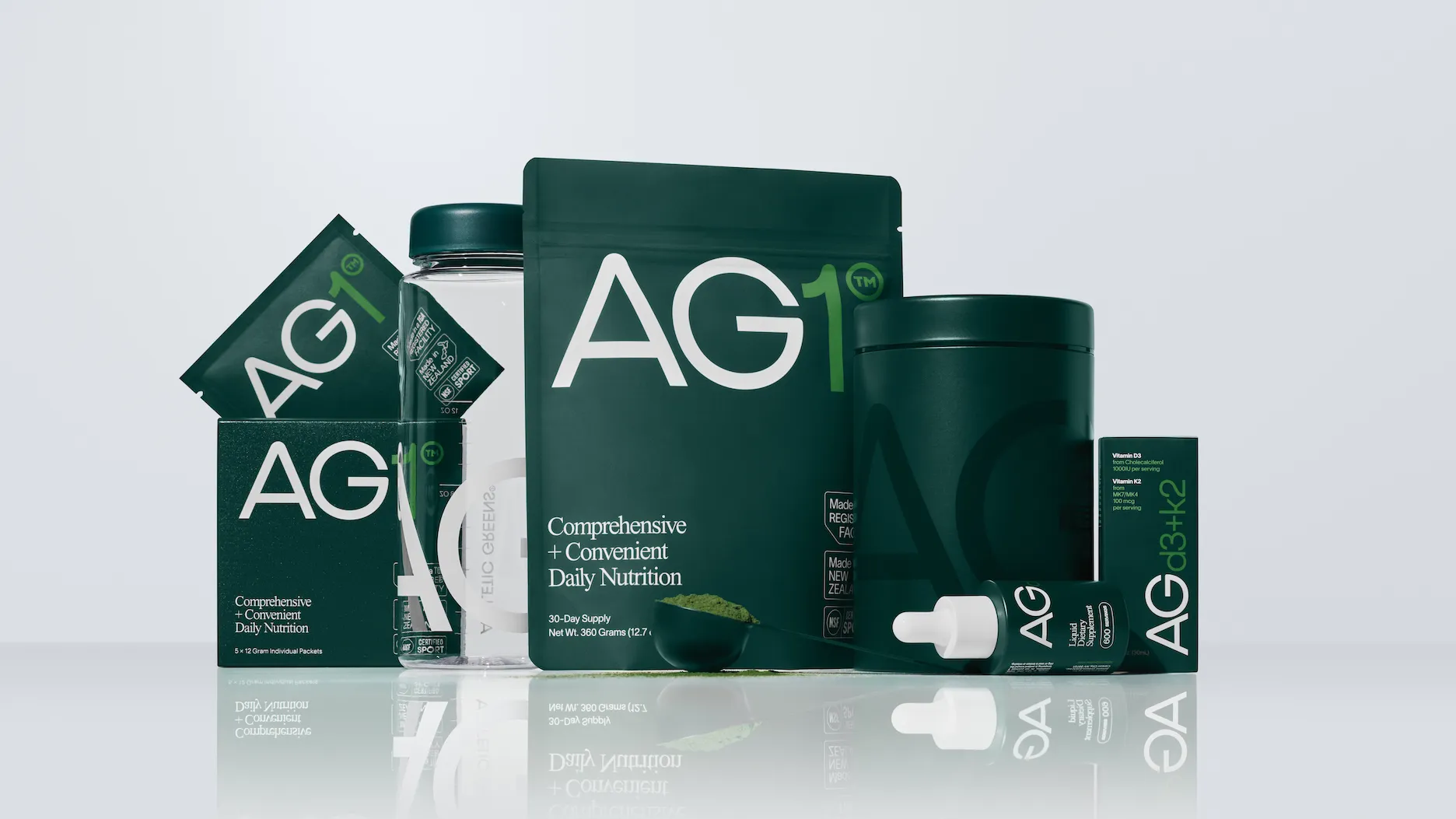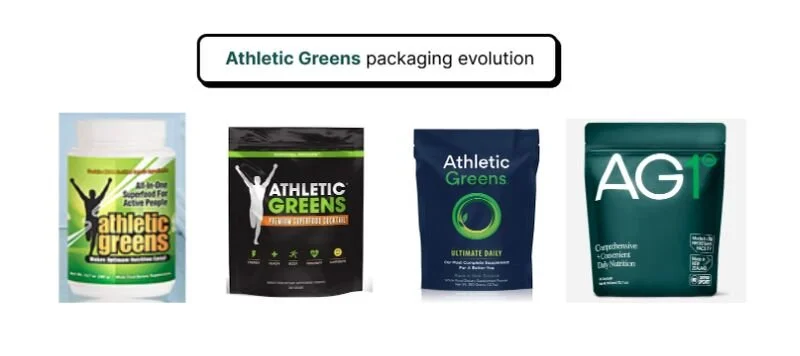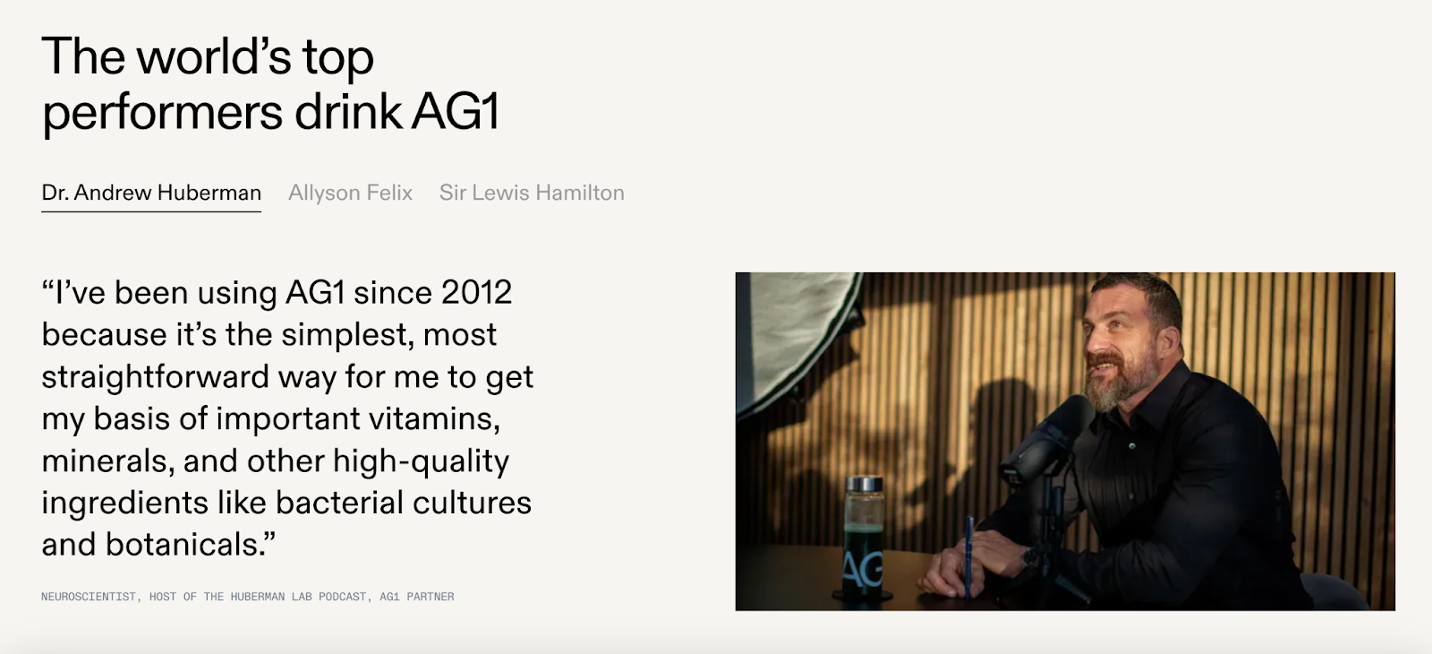AG1: Redefining Wellness, One Daily Scoop at a Time
Imagine a world where you could combine the benefits of 75 vitamins, minerals, and whole-food-sourced nutrients into a single, delicious scoop. For years, the wellness industry overwhelmed consumers with shelves filled with supplements—each promising the key to health but leaving many confused, fatigued, and still searching for a solution. AG1 (formerly Athletic Greens) stepped in to change all of that.
Launched by Chris Ashenden, AG1 didn’t just create a product; it redefined the supplement game. With its focus on simplicity, premium quality, and science-backed nutrition, AG1 has become more than a green powder—it’s a lifestyle. Let’s uncover the strategies and psychology behind AG1’s journey, and see how this brand is reshaping the wellness conversation.
1. Redefining Wellness: Positioning AG1 as a Daily Essential
AG1 didn’t just launch a greens powder — it redefined the wellness category. While traditional supplements targeted fitness enthusiasts or the aging population, AG1 widened the lens. It became the go-to solution for health-conscious individuals seeking simplicity, reliability, and daily wellness integration. From busy professionals to mindful parents, AG1 positioned itself as an essential habit—not an optional add-on.
This approach taps into brand evangelism psychology—a strategy where customers don’t just use the product, they believe in it. AG1 framed itself as a vital part of your morning routine—akin to brushing your teeth or drinking coffee. This habit-based integration helps foster emotional attachment and automaticity, turning customers into daily users and vocal advocates. They don’t just consume AG1; they live it and share it.
A bold, strategic move that solidified this shift was the brand’s evolution from Athletic Greens to AG1.
The move from “Athletic Greens” to “AG1” wasn’t just a name change — it was a bold repositioning strategy. It signaled a shift from niche sports performance to a premium, all-in-one wellness ritual.
In the psychology of branding, shorter, alphanumeric names often convey simplicity, modernity, and authority. AG1 positioned itself not just as a supplement, but as the foundational product in your health stack — clean, minimal, and science-backed. The rebrand reflected their confidence: they no longer needed to explain what they were. The product had become iconic on its own.
he new name embraced modernity, simplicity, and confidence. “AG1” evokes a sense of performance, science, and minimalism—backed by real benefits. This alphanumeric rebranding also removed the limiting “athletic” connotation, inviting a wider demographic into the fold and aligning the brand with the emerging identity of whole-self optimization.
Combined with sleek, minimalist packaging and an elevated user experience, AG1 became more than a product—it became a lifestyle. A symbol. A statement.
Brand Comparison: This approach is similar to what brands like Ritual and Seed have done in the supplement space—focusing on a streamlined, high-quality product that simplifies wellness routines and encourages routine use. However, AG1 takes it a step further by integrating the concept of holistic health and positioning itself as a complete lifestyle choice rather than a single supplement.
2. Trust Through Transparency: Quality and Integrity as Brand Pillars
AG1 has built trust by prioritizing ingredient transparency, which resonates strongly with health-conscious consumers. In a market where many products lack clarity on sourcing and efficacy, Athletic Greens differentiates itself by disclosing each ingredient’s quality and purpose. This transparency aligns with values-based branding, where the brand’s commitment to quality resonates with an audience that values honesty and integrity.
This strategy also leans on credibility psychology. By clearly communicating the rigorous testing and research behind each ingredient, AG1 reassures customers of the product’s quality and safety, which is especially important in the supplement market, where skepticism is common. Athletic Greens highlights how AG1 ingredients are sourced from high-quality suppliers and tested for bioavailability, underscoring the brand’s commitment to health.
The Psychological Impact: This commitment to transparency and quality builds consumer trust, a crucial component in establishing loyalty. By openly sharing AG1’s sourcing and testing standards, Athletic Greens creates a level of credibility that reassures customers about the efficacy and safety of the product. This approach builds long-term loyalty, positioning AG1 as a trustworthy and dependable choice within the wellness space.
3. Leveraging Authority: Influencer Partnerships that Build Trust and Community
AG1’s partnership strategy is highly selective, focusing on influencers and thought leaders who align with the brand’s values. Instead of general endorsements, Athletic Greens collaborates with figures like Tim Ferriss, Dr. Andrew Huberman, and other respected individuals in the health and wellness space. These influencers are seen as authorities, and their endorsements lend an expert-backed credibility to AG1.
This partnership strategy taps into social proof and expert authority, both of which increase the product’s perceived value. By associating AG1 with influencers who are health advocates, the brand effectively extends its message of quality and holistic health to a larger, yet carefully curated, audience. This choice of partners attracts customers who seek not just health benefits but expert approval.
Comparative Analysis: Unlike brands that use celebrity endorsements purely for visibility, Athletic Greens chooses influencers with credibility in the health space, making the endorsements feel authentic. This focus on expert influencers creates an educational angle to AG1’s branding, positioning it as a scientifically sound choice rather than a trendy product.
Deeper Insight: This selective approach to influencer partnerships also taps into psychological alignment, where consumers trust endorsements from figures they believe genuinely care about their well-being. By choosing influencers who are vocal about their own wellness routines, AG1 builds a brand narrative around authenticity and trust, which strengthens its community-driven appeal.
4. Fostering a Community of Wellness Advocates
Athletic Greens doesn’t just acquire customers—it cultivates a community of wellness advocates. The brand creates a sense of belonging by encouraging customers to see themselves as part of a shared wellness journey. This is achieved through various community initiatives, including regular wellness tips, exclusive educational content, and feedback loops that involve customers in the product’s evolution.
This focus on community aligns with relationship marketing, where the goal is to build long-term connections rather than one-time transactions. Through member-exclusive content, Athletic Greens not only keeps customers engaged but makes them feel valued and invested in the brand’s mission. This approach turns AG1 into a brand that customers actively champion, sharing their experiences and inviting others into the AG1 community.
Social Identity Theory: This strategy also leverages social identity theory, which suggests that people define themselves through the groups they belong to. AG1’s community fosters a shared identity among health-conscious individuals, creating a sense of pride and belonging that goes beyond the product. This psychological strategy enhances customer retention and encourages customers to become brand ambassadors, organically promoting AG1 to their networks.
Brand Loyalty: By positioning AG1 as more than a product—as a community-focused brand that cares about its users—Athletic Greens cultivates a base of loyal advocates. This loyalty is built on shared values and identity, transforming AG1 users into supporters who actively contribute to the brand’s growth.
5. Minimalist Design and the Power of Wellness Aesthetics
AG1’s minimalist design—clean packaging, muted colors, and modern typography—conveys simplicity and quality. Athletic Greens has positioned AG1’s branding to appeal to wellness-conscious consumers who appreciate products that not only support their health goals but also fit seamlessly into their routines and environments. The design is reflective of lifestyle branding, where the product represents an ideal rather than just a function.
The minimalist aesthetic reinforces AG1’s core brand message of “simplifying health.” This approach appeals to consumers who value products that offer quality without unnecessary complexity, positioning AG1 as a sophisticated yet accessible choice in the wellness market. By visually aligning with the aspirational wellness lifestyle, Athletic Greens ensures that AG1’s look and feel resonate with its target audience.
Psychological Impact: This minimalist design appeals to aesthetic appeal psychology, where consumers are drawn to clean, visually pleasing products that align with their lifestyle choices. This design approach also conveys purity, a concept that aligns well with the health industry and reinforces AG1’s transparency and quality messaging. AG1’s design thus makes the product feel approachable, modern, and aligned with the aesthetic values of today’s wellness consumer.
Conclusion: The AG1 Blueprint for Building a Community-Centric Wellness Brand
AG1 by Athletic Greens offers a powerful case study in building a wellness brand that goes beyond functional benefits. By positioning AG1 as an essential daily ritual, emphasizing transparency and quality, strategically leveraging credible influencer partnerships, and cultivating a strong community, Athletic Greens has successfully created a brand that resonates with consumers on multiple levels.
This strategic blend of psychological insights, community-building efforts, and values-driven branding demonstrates how wellness brands can achieve longevity and loyalty by putting authenticity and trust at the center of their strategy. AG1 has transformed a daily greens powder into a movement that embodies the principles of health, transparency, and community—a blueprint for any brand aiming to build trust, loyalty, and impact in today’s wellness-focused world.
Top 5 Essential Reads to Master AG1’s Community-Driven Branding and Wellness Strategy
1. Building a StoryBrand: Clarify Your Message So Customers Will Listen by Donald Miller
Why: Miller’s framework helps brands craft clear, customer-centered messaging, positioning the brand as a guide on the consumer’s journey. AG1’s emphasis on “simplifying health” aligns with Miller’s approach, where AG1 isn’t just a product—it’s a tool that helps consumers take charge of their wellness with clarity and confidence. Miller’s principles of storytelling show how brands can build a relationship with customers by speaking directly to their needs, making AG1 feel like an essential and trusted part of the customer’s health journey.
2. Primal Branding: Create Belief Systems that Attract Communities by Patrick Hanlon
Why: This book introduces foundational brand elements—like rituals, icons, and a creation story—that turn customers into loyal brand advocates. AG1’s daily-use positioning taps into these primal branding elements, helping customers feel connected to a larger wellness tribe with shared values. Hanlon’s insights on creating brand rituals and fostering community engagement provide a framework for AG1’s “tribal” loyalty, showing how daily use of AG1 becomes a ritual that fosters a sense of belonging and commitment.
3. Influence: The Psychology of Persuasion by Robert Cialdini
Why: Cialdini’s principles of persuasion, especially authority and social proof, are vital for understanding AG1’s selective influencer partnerships with wellness experts and thought leaders. AG1’s collaboration with figures like Tim Ferriss leverages Cialdini’s concept of authority, building credibility and trust within a highly discerning market. This book reveals how endorsements from credible authorities can reinforce customer trust and drive loyalty, especially in industries where expertise and reliability are highly valued, like wellness and supplements
4. Brand Seduction: How Neuroscience Can Help Marketers Build Memorable Brands by Daryl Weber
Why: Daryl Weber’s book dives into the neuroscience of branding, exploring how brands can engage customers’ subconscious minds and create lasting impressions. Brand Seduction offers insights into the psychological aspects of brand loyalty and memory, which help explain AG1’s ability to position its product as a daily ritual.
5. Contagious: Why Things Catch On by Jonah Berger
Why: Berger’s research on why people talk about and share products highlights the principles behind AG1’s word-of-mouth growth. AG1’s community and influencer strategy align with Berger’s ideas on social currency and social proof, showing how brands can naturally inspire conversations and recommendations. Contagious provides actionable insights into making a brand inherently shareable, explaining how AG1’s social proof and community advocacy generate organic growth, making the brand feel like a trusted health movement.




